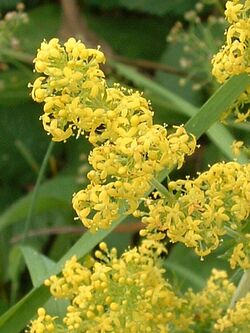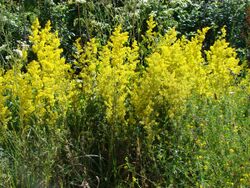Biology:Galium verum
| Galium verum | |
|---|---|

| |
| Scientific classification | |
| Kingdom: | Plantae |
| Clade: | Tracheophytes |
| Clade: | Angiosperms |
| Clade: | Eudicots |
| Clade: | Asterids |
| Order: | Gentianales |
| Family: | Rubiaceae |
| Genus: | Galium |
| Species: | G. verum
|
| Binomial name | |
| Galium verum | |
Galium verum (lady's bedstraw[1] or yellow bedstraw) is a herbaceous perennial plant of the family Rubiaceae. It is widespread across most of Europe, North Africa, and temperate Asia from Israel, Lebanon and Turkey to Japan and Kamchatka. It is naturalized in Tasmania, New Zealand, Canada, and the northern half of the United States. It is considered a noxious weed in some places.[2][3][4]
Galium verum is a low scrambling plant, with the stems growing to 60–120 centimetres (24–47 in) long, frequently rooting where they touch the ground. The leaves are 1–3 cm (0.39–1.18 in) long and 2 millimetres (0.079 in) broad, shiny dark green, hairy underneath, borne in whorls of 8–12. The flowers are 2–3 mm (0.079–0.118 in) in diameter, yellow, and produced in dense clusters. This species is sometimes confused with Galium odoratum, a species with traditional culinary uses.[5]
Uses
In medieval Europe, the dried plants were used to stuff mattresses,[6] as the coumarin scent of the plants acts as a flea repellant. The flowers were also used to coagulate milk in cheese manufacture (which gives the plant its name, from the Greek word γάλα, gala 'milk') and, in Gloucestershire, to colour the cheese double Gloucester.[7] The plant is also used to make red madder-like and yellow dyes. In Denmark, the plant (known locally as gul snerre) is traditionally used to infuse spirits, making the uniquely Danish drink bjæsk (da).
Mythology
Frigg was the goddess of married women, in Norse mythology. She helped women give birth to children, and as Scandinavians used the plant lady's bedstraw (Galium verum) as a sedative, they called it Frigg's grass.[8]
In Romanian folklore, it is called sânziana and it is linked to the Sânziene fairies and their festival on June 24.[citation needed]
In Gaelic mythology, the hero Cú Chulainn, who suffered fits of rage during battle, would take a tea of this plant to calm his frenzy.[citation needed] The plant is known as lus chneas Chù-Chulainn 'the herb of Cú Chulainn's skin' in Scottish Gaelic,[9] and in the 14th/15th centuries it occurred with the Irish name Bolad cneise con Culainn ‘the smell of Cú Chulainn’s skin’ (NLI G 11 182b2).[10]
In Serbian folklore Ivanjski venci (Midsummer wreaths) are made out of Galium verum the day ahead of Nativity of John the Baptist celebration.[11][12] Galium verum, decorated with other flowers, symbolize the beauty of nature and are placed at the public roadside front gates because they are believed to protect Christian homes.[11]
Subspecies
Many varietal and subspecific names have been proposed, but only four are currently (May 2014) recognized:[2]
- Galium verum subsp. asiaticum (Nakai) T.Yamaz - China, Korea, Japan, Russian Far East (Primorye)
- Galium verum subsp. glabrescens Ehrend. - Iran, Iraq, Turkey, Syria
- Galium verum subsp. verum - most of species range
- Galium verum subsp. wirtgenii (F.W.Schultz) Oborny - Central and eastern Europe plus Western Siberia
Gallery
References
- ↑ (xls) BSBI List 2007, Botanical Society of Britain and Ireland, https://bsbi.org/download/3542/, retrieved 2014-10-17
- ↑ 2.0 2.1 Kew World Checklist of Selected Plant Families
- ↑ Biota of North America Program
- ↑ Altervista Flora Italiana
- ↑ Flora of China, v 19 p 139, 蓬子菜 peng zi cai, Galium verum
- ↑ Niering, William A.; Olmstead, Nancy C. (1985). The Audubon Society Field Guide to North American Wildflowers, Eastern Region. Knopf. p. 764. ISBN 0-394-50432-1.
- ↑ Howard, Michael A. (1987). Traditional Folk Remedies: A Comprehensive Herbal. Random House of Canada. pp. 163–. ISBN 0-7126-1731-0.
- ↑ Schön, Ebbe (2004). Asa-Tors Hammare: Gudar och Jättar i Tro och Tradition. Värnamo: Fält & Hässler. pp. 228–. ISBN 91-89660-41-2.
- ↑ "lus chneas Chù-Chulainn". http://www.cairnwater.co.uk/faclair/ViewEntry.aspx?ID=0B49BF5FAC3E847BD8AAB218426D1807.
- ↑ "Dublin, National Library of Ireland, MS G 11". https://www.vanhamel.nl/codecs/Dublin,_National_Library_of_Ireland,_MS_G_11.
- ↑ 11.0 11.1 Slavko Bubalo (7 July 2023). "Tradiciju pletenja ivanjdanskih venaca prenose na mlade". Srbi.hr, Joint Council of Municipalities. https://srbi.hr/tradiciju-pletenja-ivanjdanskih-venaca-prenose-na-mlade/.
- ↑ Senka Lučić (4 July 2007). "Ivanjski venci, "moravci" i maske "kod vrapca"". Politika. https://www.politika.rs/sr/clanak/2678/Specijalni-dodaci/Ivanjski-venci-moravci-i-maske-kod-vrapca.
External links
- Line drawing from Flora of Pakistan
- Photo of herbarium specimen at University of Missouri, collected in Missouri, Galium verum
- Plants for a Future
- US Department of Agriculture plants profile
- Botanical.com, a modern herbal by M. Grieve
- NaturGate, Luontoportti, Helsinki, Lady's Bedstraw, Galium verum
- Emorsgate seeds, wild seeds of the UK, Galium verum – Lady's Bedstraw
- Herbal Encounter, Lady’s Bedstraw (Galium Verum)
- Minnesota Wildflowers
- Wilde Planten in Nederland en Belgie, Geel walstro, Giel slyt, Lady's Bedstraw (Yellow Spring Bedstraw, Cheese Rennet, Fleaweed, Gallion, Ladys Bedstraw, Maidens Hair, Petty Mugget, Wirtgen's Bedstraw, Wirtgens Bedstraw), Gaillet jaune, Echtes Labkraut, Galium verum
- Altervista, Galium verum L. - Erba zolfina, Le piante e le erbe medicinali
Wikidata ☰ Q156854 entry
 |









